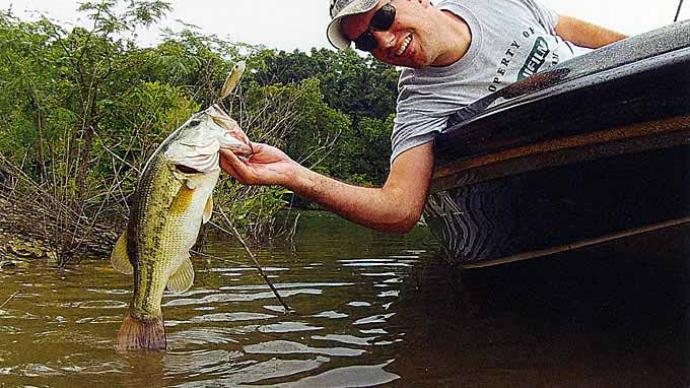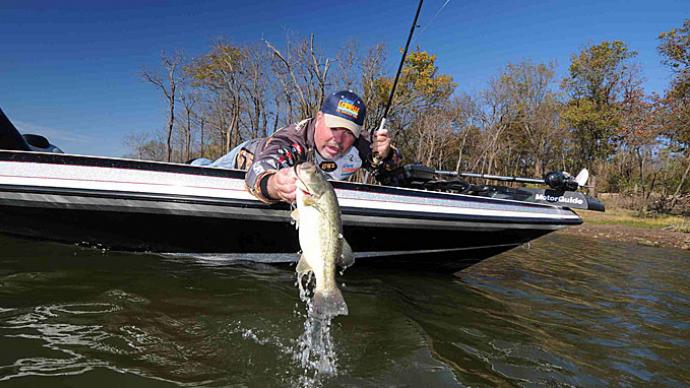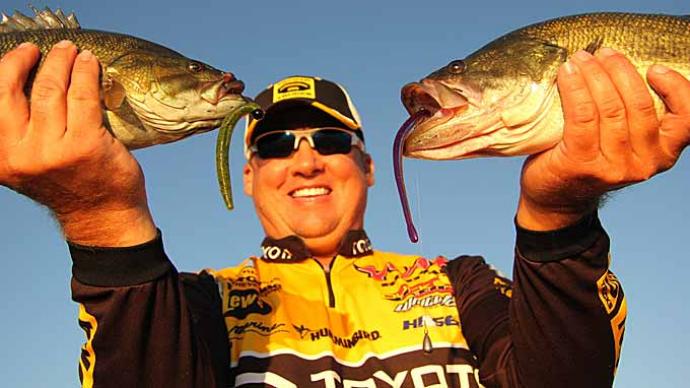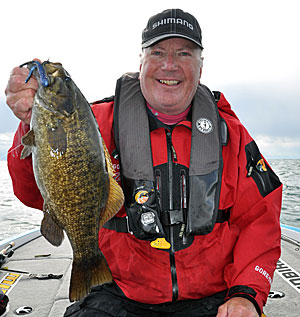
Let’s be honest. If we all had our way, each day would be spent power fishing for smallmouth bass. However, in the land of smallmouth, not all goes according to plan. Enter the spinning rod and three sure-fire approaches to put the weariest smallmouth in the boat.
Ice Cold Logic
Simon Frost is a premier guide (http://simonfrost.ca) from Ontario, Canada. He is known for finding better-than-average fish, reading their mood, and offering the right bait at the optimal time. For Frost, properly working a tube jig is one of his most consistent techniques for producing big smallmouth.
The tube especially excels when fish are not actively feeding, directly after a cold-front, or if the water has recently cooled down a few degrees as they will specifically relate to the bottom. “A dropshot will go right over their head whereas a tube jig you can put the bait right in their face, slow the presentation down, and keep it there longer,” Frost reasoned. Any time that Frost can see super-neutral fish hugging bottom on his Humminbird Onyx 10 and 1199 units, or if he knows they’re feeding on crayfish or gobies, the tube jig makes for an excellent choice to replicate the forage base. Fishing a tube jig has proven effective for Frost when combating a high barometric pressure system that forces smallmouth to relate to the bottom.
Working a Tube
While there is no wrong way to work a tube when smallmouth are active, there are better ways than others to get them to bite, especially when they aren’t in the mood to feed. Simply yo-yoing a tube around the smallmouth you’ve located can be the ticket during early spring. As the water starts to warm, snapping a tube off the bottom often gets their attention. Frost reminds anglers that the warmer it is, the more apt smallmouth will be to feed. Alternatively, once cold weather arrives, smallmouth want that tube presented right before them and using a slow to extremely still presentation. Frost might resort to wiggling the rod tip and making it dance in its spot while never leaving the bottom.
Catching 100 smallmouth per day is not unreasonable when the fish are feeding. However, when the bite is tough, you did well if you got 25 fish to bite. Frost, a seasoned guide on Erie, Ontario, and Simcoe is confident he can get them to go. “You can get smallmouth to feed any time during the day, they will feed more actively during specific times of the day, but they can be caught all day long,” Frost said.
Gear Check
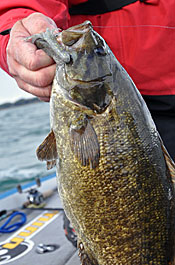
Frost is super picky about every rod, reel, and piece of tackle that goes in his boat. The minute it underperforms, it’s out of the rotation. Frost prefers the Shimano 7-2 medium-heavy spinning rod. It has the perfect action for detecting the bite and driving the hook set home with enough forgiveness to land the most forceful of smallmouth. He’ll pair it with a Shimano Sustain 3000 series reel spooled with green colored 5-pound Power Pro braided line while running an 8- to 10-pound BPS XPS fluorocarbon leader. While many might scoff at his choice of using such a light test, he’s never broken the line. The thin diameter means he can put more on his spool, make longer casts, yet enjoy all the sensitivity that braid offers while getting his bait to the bottom faster.
For anyone who knows Frost, it’s no secret that he is obsessive with the tubes that he uses. He’s always looking for the softest plastic, the best salt concentration, and critical color patterns that best replicate the forage he is trying to mimic. His primary tube of choice is the BPS Tender Tube due to its slender design. “I prefer thinner ones because they are softer, and I find fish hold them longer, and because they are thinner, I get better hook penetration,” he said. “Bass Pro Tender Tubes are so good because they are soft, and the fish hold them.” Frost uses a 3.5-inch tube for all of his smallmouth fishing.
While some anglers believe tube jigs should be light enough to slowly spiral through the water column and crawl along the bottom, Frost has no time for such logic. “I normally use heavy weights all the time. I’m looking for a reaction bite. If it’s dead calm, any time of the year, in 30 feet, I’ll throw a ½-ounce head, I’ll go to ¼-ounce in 2- to 10- feet, 3/8 in 10- to 15- feet, but the ½-ounce is my mainstay,” Frost explained. When fishing waters 40- to 50- feet deep or when faced with rough water, he won’t hesitate to use a ¾-ounce head that he pours himself. Frost will use the spot lock feature on his Minn Kota Terrova to hold his boat, point into the waves when he can, or toss two giant 60’ drift socks over the side to help him slow down the drift properly present his tube jig.
Frost is quite selective about the tubes he throws, their salt content, texture, and plastic quality. They won’t even get a second look if the colors aren't spot on. He’ll rotate through a few patterns during the day until the fish let him know what is working. If the bite is tough, he’s found Smelly Jelly to be at the top of his list. He’s had days where no bites turned into a bunch of bites, and sometimes adding scent is the trick needed to entice smallmouth to bite and hold on to the tube longer.
The Bite
Smallmouth are anything but predictable, especially the way they strike a tube. Sometimes the fish will hit the bait head-first. They’ll turn the bait around in their mouth, and then they are notorious for hitting the bait and spitting it immediately. Frost advises anglers to set the hook immediately and hard to drive the hook point home.
Dropping Down on Them
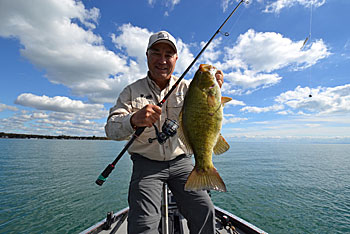
Bob Izumi is no stranger to the winner’s circle, having won the 2011 FLW Everstart Northern Division 1,000 Islands Champion and is a three-time Canadian Open champ. He’s easily Canada’s most recognizable fishing personality. He spends his fair share of time on the water filming his “Real Fishing” television show that compliments his magazine and radio program. Please make no mistake, he’s wired for bass fishing every second of every day, and the drop shot is an essential tool in his arsenal.
Why It Shines
Izumi acknowledges that the tube jig can be essential for his game plan during most smallmouth tournaments. Once the drop shot came on the scene, it opened a new way of catching smallmouth bass. “It allowed you to put a bait, from a few inches to a few feet off the bottom, and opened up a whole new way of finesse fishing for smallmouth, especially when conditions get tough,” Izumi started. “The obvious advantage of the drop shot was that you don’t have to keep switching jig head weights with tubes to get the right fall rate.”
Technique Logic
Izumi most often keeps his presentation vertical, but he’s learned that making a long cast can be critical. He’ll launch his bait in good ways, let it sink to the bottom, tighten up his line, leave it stationary, and then crawl it ever so slightly and repeat. This technique shines especially when fishing in clear water when smallmouth can get boat shy.
Whether Izumi is dropping his bait down to fish that he saw on his Lowrance Gen 3 12-inch units or making long casts, he certainly has no intention of moving or shaking his bait. “The biggest thing with a drop shot is keeping a fairly tight line so that your sinker is on the bottom and your bait is off the bottom. I will vary the length of my lead depending on what fish are doing on the graph,” Izumi said. “If fish are 2- to 3- feet off the bottom and layered thick, I’ll run an 18- to 20- inch lead from the hook to the weight. I do that because it will appeal to some of the fish below and to the fish that have it in front of their face.” Should Izumi mark individual fish or fish holding closer to the bottom, he’ll run a 10-inch lead. Since your line is rarely perfectly vertical, you can expect that your line will be 4- to 6- inches from the bottom since your line is off on an angle.
Shaking your rod tip to give the bait action is frowned upon most often. “I can’t stress it enough, but I don’t put any action. If I’m site fishing, I might quiver the rod tip and try to create a reaction strike, but for the most part, I like to tight-line it and not move it, then wait until my rod loads up. I think you catch more fish by letting it sit there instead of shaking the bait,” Izumi explained.
Tackle Tricks
If the water is flat and Izumi is fishing 12 feet of water or less, he’ll go with a 1/8 or ¼-ounce Ultra Tungsten dropshot weight. Depths of 18- to 24- feet call for a 3/8-ounce sinker, while anything deeper than 24 feet calls for a ½-ounce to maintain contact with the bottom. When fishing rivers like St. Lawrence or Niagara, he’ll opt for a 5/8 or even ¾-ounce size, especially when fishing rough water. All sinkers get tied on with an overhand knot- they aren’t cheap! By all means, when fishing snag-infested waters, revert to lead!
The 7-6 Abu Garcia Fantasista Regista, Izumi's drop shot rod, has a light tip but plenty of backbone. He prefers a 7-foot Fantasista Regista or a Mike Iaconelli Signature series rod when targeting shallow water smallmouth. Regardless of the rod, he prefers an Abu Garcia MGX spinning reel as he’s found that 10-pound Berkley 100% Fluorocarbon comes off the spool with less memory. Rarely does Izumi fish anything lighter than 10-pound line- he’s never needed to.
Efficiency is paramount for a tournament angler so that Izumi will have several dropshot rigs pre-tied with a #10 swivel for easy re-tying. He’ll wrap multiple rigs around a pool noodle for quick re-rigging.
Izumi’s favorite bait is a Berkley Gulp! 3-inch Fry in green pumpkin, after all, he’s won three tournaments with it! Sure it’s subtle, but it’s also loaded with Gulp! Formula. You can bet he’ll be soaking his baits in Berkley Gulp when money is on the line! Marinade. Beware, the smell is potent! He’ll also rotate in the 3-inch Gulp! Minnow and Twitchtail Minnow that he’ll rig on a #1 or 1/0 Berkley Fusion 19 hook. Izumi keeps his color selection simple, opting for subtle colors when faced with clear water. Still, when faced with dirty water, he subscribes to VanDam's logic by using more visible colors like purple.
One bait that Izumi has never talked about is the Berkley Gulp! Hellgrammite - a coveted secret bait for years. The Hellgrammite is simply a scent-infused bug that catches big fish when fish shut down on other baits.
When smallmouth fishing, its always important to keep an ace back because you will never know when you need it. Izumi won the 2011 FLW Everstart Northern Division 1,000 Islands Champion by a pound, and he recalls getting one fish to go that wouldn’t bite what he’d previously offered. Once he switched to a Set The Hook Crush Worm in the “Girls Best Friend” pattern, he caught an important fish that helped close the deal.
His patented phrase, “you’ve got to keep an open mind and let the fish tell you what they want,” should not fall on deaf ears for anyone who has ever spoken with Izumi. When sight fishing in shallow water, Izumi uses a Berkley Havoc Rocket Craw that he’ll bite a ½-inch off the body because it offers fish something different and more compact. “There have been times when I’ve gone through my rotation of baits, and the fish won’t go, but once I switch to the Rocket Craw, those fish will fire up again,” Izumi explained.
Using your Eyes Under the Water
Izumi relies on Lowrance Gen 3 units and prefers to use the 12-inch screens to paint him a picture of what is going on underwater. Using a Navionics Fish ‘n’ Chip helps him understand the intricate bottom contours and where to start looking. He’ll start scanning with 2d imaging and turn up the sensitivity as high as possible. When dropping his bait down to a marked fish, it’s essential to know exactly where the bait is relative to the fish so he’ll bump up the chart speed allowing for a faster refresh rate of his display. He’ll use the down and side-scan features to key in on essential areas shown on his map and those he’s found. Once he marks a fish, Izumi will drop his bait down to the fish on the screen, knowing his livewell is about to get crowded.
Flick Shake
Experience has taught Mark Zona, host of Zona’s Awesome Fishing Show, that while both the tube and drop shot can be productive, there are times when even these are not the answer.
Outthink them, outwork them

If you’ve ever witnessed smallmouth bass swim around shallows like zombies, devoid of any interest in the bait, live or artificial, then pay attention. There is a window from mid-Sept to mid-October, where big smallmouth goes shallow and roam, wanting nothing to do with anything you have to offer. Zona can’t always pick when he wants to film a show, and sometimes, the conditions are less than optimal. There are times on lakes he fishes that whether he’s fishing 20 feet of water or less to 6-inches of water when smallmouth are faced with painfully light wind conditions, high barometric pressure, and high skies, they will zone out.
That said, Zona keyed into an incredible deal a few years back that put fish in the boat and saved his show. On the given day, the conditions were very calm, and Zona had no problem spotting the big fish that kept swimming around the area he was fishing. They still wouldn't have touched them if he’d scaled down to a 1/8-ounce dropshot rig or tube. Zona quickly noticed that they weren’t, “Feeding down like that.”
What was most frustrating was that he could see 4- and 5-pound smallmouth everywhere that wouldn’t bite. Zona shook his head in disbelief. He saw a 5-inch green pumpkin leach swimming 5-inches under the surface and then several more. In all his years of fishing, he’d never witnessed such a thing.
Tackle Logic
Zona dug into his tackle box, tied on a Jackall 3/32 head, and removed the weed guard before rigging a green sapphire Strike King Fat Finesse Worm hooked through the middle. He prefers that specific worm because compared to a regular finesse worm, allowing for a quicker rate of fall. When conditions warrant it, he’ll go up to a 1/8-ounce and scale down to a 1/16.
Finding the right bait was only part of the deal-the approach is critical. Zona visually hunts for individual bass with his MotorGuide trolling motor on high, believing that smallmouth will let you know if they are available. “If he darts out off the break and he’s gone, that’s bad! But, if he’s up there cruising, he’s there to eat, but they don’t want to get caught,” Zona explained. He’s tactical in his approach so as not to spook the fish so he can read their behavior for clues. “I rarely see bass and just fire. I watch his direction. These aren’t spawners. These are fish up there feeding. They tend to have a happy area they want to be in, and I watch how they act when I see them, leave the area, and turn around and cast,” Zona started. “If I stop, I’m lucky to catch one fish, but if I keep going and turn around, I’ll catch them nine times out of 10. Once you fire a cast at them, they’ll roam off, circle back, and cream it. They become very territorial with this technique.”
Equally important is using the right set-up. “People lose fish on flick shake because they cut the fish,” Zona explained. He’s found a saltwater popping rod to do the trick. The same rod he figures into his jerkbait approaches as well. The G-Loomis GLX PR 844 paired with the new Shimano Stradic 3000 spooled with 10-pound Power Pro Super Slick and a 6-foot leader of 6- to 8-pound BPS XPS fluorocarbon has become his weapon of choice. He prefers the bright blue braided line so he can watch his line to detect the slightest bite. His drag is backed off from the onset because all you need to do is start reeling once they commit to the bait. Once the battle is on, he’ll tighten up a hair. Zona cautions anglers that the hook will slice into them if the drag is too tight, and they’ll pull off.
When it comes to working the bait, Zona is very particular. “I’m never letting that bait get to the bottom. Twitch twitch-twitch pull, kill it, pull twitch-twitch kill it,” Zona said.
“The only time I give up on a fish is if I can’t find them again. Other than that, I stay on them.”


